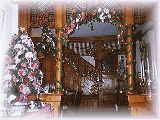
Christmas decorations are a mixture of old and new
traditions.One of the oldest is the gathering of evergreens for the house. This has been going on since before christianity, and was associated with very early mid-winter festivals.
Holly, with its glossy leaves and shining red berries, is a cheerful sight on cold wintery days and this is why we bring it inside. It reminds us that some shrubs bloom in spite of snow and frosts and that life will return to all other trees and shrubs in the spring. Holly wreaths on the front door are a sign of good luck.
Ivy, too, has shining leaves that cling to walls and branches whatever the weather. Ivy is a sign of friendship, remaining firm and strong for years, so it is particularly popular at Christmas when we remember our friends.
Mistletoe, with its distinctive white berries, grows on apple trees in orchards. An old tradition says that if friends meet under mistletoe they will both have good fortune, and that if enemies meet then they will stop quarrelling. If you hang a spray of mistletoe in your house you can claim a kiss from anyone standing beneath it.
During the long reign of queen Victoria, tinsel, garlands, candles adn lights were added to evergreens as Christmas Decorations. Christmas trees also became popular around this time. Christmas crackers, so familiar today, began as a pretty way of wrapping sweets. Printed mottoes and funny riddles were added by a Londoner called Tom Smith. But the idea really caught on when he was inspired by seeing a log fire sparkle and crackle, and managed to think up a way of getting thin strips of cardboard to explode inside the coloured wrappings. Tom Smith started the first cracker factory, and though he added tiny toys and paper hats, he insisted that every craker must have a motto, or a joke and riddle as well. Nowadays, crackers are such a favourite part of the celebrations that Christmas dinner simply wouldn't be the same without them.